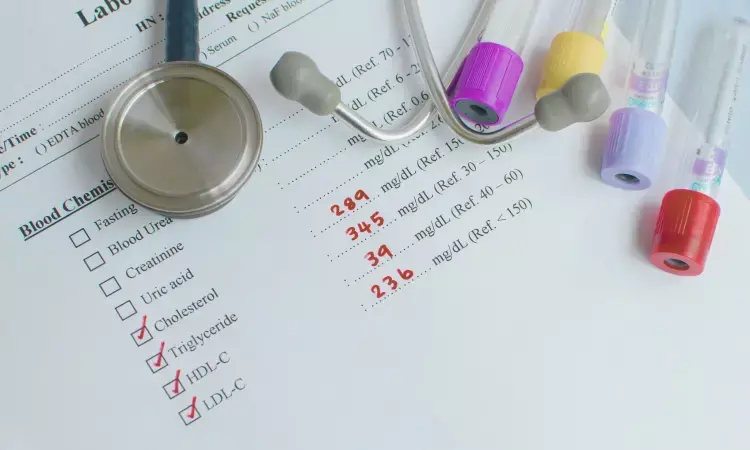- Home
- Medical news & Guidelines
- Anesthesiology
- Cardiology and CTVS
- Critical Care
- Dentistry
- Dermatology
- Diabetes and Endocrinology
- ENT
- Gastroenterology
- Medicine
- Nephrology
- Neurology
- Obstretics-Gynaecology
- Oncology
- Ophthalmology
- Orthopaedics
- Pediatrics-Neonatology
- Psychiatry
- Pulmonology
- Radiology
- Surgery
- Urology
- Laboratory Medicine
- Diet
- Nursing
- Paramedical
- Physiotherapy
- Health news
- Fact Check
- Bone Health Fact Check
- Brain Health Fact Check
- Cancer Related Fact Check
- Child Care Fact Check
- Dental and oral health fact check
- Diabetes and metabolic health fact check
- Diet and Nutrition Fact Check
- Eye and ENT Care Fact Check
- Fitness fact check
- Gut health fact check
- Heart health fact check
- Kidney health fact check
- Medical education fact check
- Men's health fact check
- Respiratory fact check
- Skin and hair care fact check
- Vaccine and Immunization fact check
- Women's health fact check
- AYUSH
- State News
- Andaman and Nicobar Islands
- Andhra Pradesh
- Arunachal Pradesh
- Assam
- Bihar
- Chandigarh
- Chattisgarh
- Dadra and Nagar Haveli
- Daman and Diu
- Delhi
- Goa
- Gujarat
- Haryana
- Himachal Pradesh
- Jammu & Kashmir
- Jharkhand
- Karnataka
- Kerala
- Ladakh
- Lakshadweep
- Madhya Pradesh
- Maharashtra
- Manipur
- Meghalaya
- Mizoram
- Nagaland
- Odisha
- Puducherry
- Punjab
- Rajasthan
- Sikkim
- Tamil Nadu
- Telangana
- Tripura
- Uttar Pradesh
- Uttrakhand
- West Bengal
- Medical Education
- Industry
Monthly Olezarsen Significantly Lowers Triglycerides in High-Risk Patients: NEJM

A new study published in The New England Journal of Medicine found that a once-monthly injection of olezarsen reduced triglyceride levels by up to 60% in adults with moderate hypertriglyceridemia and elevated cardiovascular risk, with over 80% achieving normal triglyceride levels at 6 months.
Olezarsen, an experimental N-acetylgalactosamine–conjugated antisense oligonucleotide, targets messenger RNA of apolipoprotein C-III, which is a protein that impairs the clearance of triglycerides from the bloodstream. By blocking this protein, olezarsen facilitates faster removal of triglycerides, addressing a core mechanism of the disorder.
The phase 3 trial enrolled 1,349 participants who had either moderate hypertriglyceridemia, defined as triglyceride levels between 150 and 499 milligrams per deciliter, combined with elevated cardiovascular risk, or severe hypertriglyceridemia with levels exceeding 500 mg/dL. The participants were randomly assigned to receive monthly subcutaneous injections of olezarsen at either 50 milligrams or 80 milligrams, or to receive a placebo.
The primary outcome was the percent change in triglyceride levels after 6 months of treatment. These results found triglyceride levels fell by 58.4% with the 50-mg dose and 60.6% with the 80-mg dose when compared to placebo. Both results were statistically highly significant, with confidence intervals confirming consistency across the patient groups.
The study population was diverse, with a median age of 64 years and 40% women. The baseline median triglyceride level was 238.5 mg/dL, with most patients falling between 190.5 and 307.5 mg/dL. Also, reductions were consistent across both olezarsen dosage groups, highlighting the robust efficacy of the drug.
The incidence of serious adverse events was similar between the drug-treated groups and the placebo group, indicating that the therapy does not appear to introduce new risks despite its powerful lipid-lowering effects.
Overall, the results position olezarsen as a promising new option for patients struggling with high triglycerides, particularly those at elevated risk for heart attacks, strokes, or pancreatitis. By achieving reductions of more than half in triglyceride levels, the effect of olezarsen size surpasses most current therapies, like fibrates or omega-3 fatty acids, which typically deliver more modest improvements.
Source:
Bergmark, B. A., Marston, N. A., Prohaska, T. A., Alexander, V. J., Zimerman, A., Moura, F. A., Kang, Y. M., Weinland, J., Murphy, S. A., Goodrich, E. L., Zhang, S., Li, D., Banach, M., Stroes, E., Lu, M. T., Tsimikas, S., Giugliano, R. P., & Sabatine, M. S. (2025). Targeting APOC3 with olezarsen in moderate hypertriglyceridemia. The New England Journal of Medicine,. https://doi.org/10.1056/nejmoa2507227
Neuroscience Masters graduate
Jacinthlyn Sylvia, a Neuroscience Master's graduate from Chennai has worked extensively in deciphering the neurobiology of cognition and motor control in aging. She also has spread-out exposure to Neurosurgery from her Bachelor’s. She is currently involved in active Neuro-Oncology research. She is an upcoming neuroscientist with a fiery passion for writing. Her news cover at Medical Dialogues feature recent discoveries and updates from the healthcare and biomedical research fields. She can be reached at editorial@medicaldialogues.in
Dr Kamal Kant Kohli-MBBS, DTCD- a chest specialist with more than 30 years of practice and a flair for writing clinical articles, Dr Kamal Kant Kohli joined Medical Dialogues as a Chief Editor of Medical News. Besides writing articles, as an editor, he proofreads and verifies all the medical content published on Medical Dialogues including those coming from journals, studies,medical conferences,guidelines etc. Email: drkohli@medicaldialogues.in. Contact no. 011-43720751


